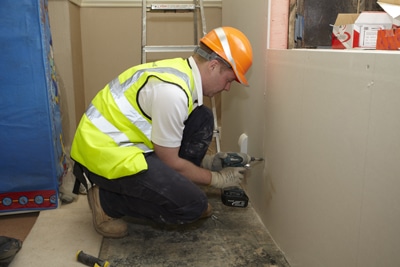Despite the perceived failings of Green Deal there is still a commitment to raise the energy efficiency standards of housing. There are just under seven million solid wall homes in the UK and the market offers huge opportunity for contractors. It is possible to improve the thermal performance of solid walls by adding insulation either internally or externally and Tony Millichap, technical manager at Kingspan Insulation, profiles some real life examples of internal wall insulation on homes in Lancashire.
 One of the most important factors influencing fuel poverty is poor standards of housing, with many solid walled properties remaining uninsulated across the UK. There is a skill to installing Solid Wall Insulation (SWI) in order to get the best results, but those involved in the installation rarely get the chance to see just what a difference their handiwork has made.
One of the most important factors influencing fuel poverty is poor standards of housing, with many solid walled properties remaining uninsulated across the UK. There is a skill to installing Solid Wall Insulation (SWI) in order to get the best results, but those involved in the installation rarely get the chance to see just what a difference their handiwork has made.
A recent field study of 36 hard-to-treat existing dwellings in England was undertaken by the Energy Saving Trust (EST) to quantify the energy-efficiency benefits that result from upgrading levels of SWI.
This case study focuses on the results from two properties in Lancashire; one in the seaside town of Morecambe and one in the market town of Burnley, which were upgraded using premium performance rigid modified resin internal wall insulation (IWI). In both cases the IWI was installed with due care and attention to detailing around joints, openings and junctions by experienced dry-lining operatives, employed by Mansell Projects Ltd, a reputable contractor with a long history in professional dry-lining.
The property in Morecambe was a pre-1900, two-storey end-terrace dwelling with 500 mm thick stone walls. The owners preferred IWI over EWI since they did not want the rustic stone façade to be concealed. Furthermore, the dwelling was situated in a conservation zone, which may have made the granting of planning permission for works to the exterior of the property more difficult. The retrofit was completed without the owners having to leave their home, allowing them to be involved in decisions about both the finish and aesthetics of the work.
The selected system was the Kingspan Kooltherm K18 Insulated Dry-Lining System: comprising 92.5 mm thick Kingspan Kooltherm K18 Insulated Plasterboard and a range of ancillary fixing components that satisfy stringent performance specification requirements.
Wall U-value measurements showed an 83 per cent improvement in the thermal performance of the treated walls. The build-up enabled the achievement of a final U-value of 0.215 W/m2.K, which comfortably exceeds the target performance outlined in Approved Document L1B.
The EST monitoring program at the house revealed a 20 per cent saving in normalised annual gas consumption for primary space heating. Although auxiliary heating was provided by a dual fuel fire, which was later confirmed as being the main heat source for the ground floor living space, its contribution could not be measured, so the true savings are potentially even greater.
The gas usage in the pre-insulation period was constant throughout the day, whereas morning and afternoon heating in the post-insulation period was almost entirely absent. This indicates that the alleviation of heat loss resulting from the improved thermal performance of the walls had enabled the owners to maintain comfortable daytime temperatures without additional heating.
The property in Burnley was a pre-1900, 3-storey mid-terrace also with 500 mm thick stone walls. The area surrounding the property was part of an ongoing renewal project (a property “face-lifting” scheme in Burnley) and so external works were restricted. IWI was therefore the preferred option.
The same dry-lining system was installed by Mansell Projects, incorporating 92.5 mm thick Kingspan Kooltherm K18 Insulated Plasterboard mechanically fixed to 25 x 50 mm pre-treated timber battens, lined with 100 mm wide DPC strips. This provided a U-value of 0.18 W/m2.K – an outstanding result for an insulated solid wall, demonstrating a significant improvement of 89 per cent over the original performance, the level of airtightness was also improved by a considerable 57 per cent.
The effectiveness of the system is highlighted in the thermal images taken after the installation, particularly at junction locations where the cold regions appear to have been minimised. This, combined with the reduced air-leakage, emphasises the positive impact of proper installation practice and good detailing.
A study of the heating behaviour patterns at the property indicated that the increased thermal efficiency of the building envelope has enhanced its ability to retain heat and enabled a reduction in both the intensity and duration of heating events to achieve the desired temperature.
Following the installation the results at the Burnley property have shown an impressive 45 per cent decrease in normalised annual gas consumption for primary space heating, with a corresponding reduction in both CO2 emissions and heating bills for the owners, whilst allowing them to enjoy an increase in average indoor temperature.
Although the results at the property in Morecambe were less dramatic, this was a likely result of the unmonitored auxiliary heating system and the high level of uncontrolled air-leakage through the roof and floor which were not treated as part of the project; the savings were still sizeable.
The careful attention to detail at junctions and improved airtightness meant that no issues with condensation were identified at either property following the installation.
For further information on IWI please go to www.kingspaninsulation.co.uk/iwisystems.


